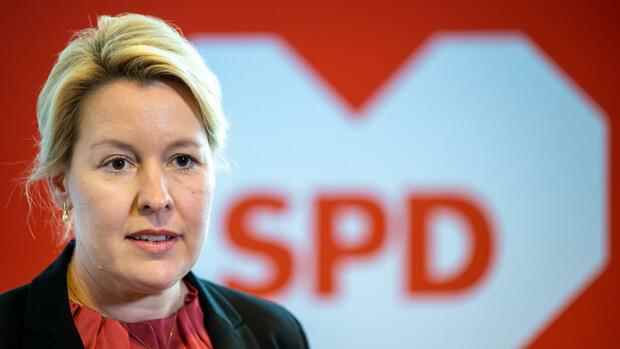The top SPD politician in Berlin relies on a three-party coalition – without the CDU.
(Photo: dpa)
Berlin First important decision after the parliamentary elections in Berlin, but no clear preliminary decision for the formation of a government: The SPD, as the winner of the election, announced on Friday that it now wants to speak in two three-way formats about the formation of a government.
In the coming week, on the one hand, explorations with the Greens and the FDP are planned, on the other hand with the Greens and the Left, said the SPD’s top candidate in the House of Representatives election and designated Governing Mayor Franziska Giffey.
The preference for the SPD is a traffic light alliance with the Greens and the FDP, she added. “This preference is based on the development that we are currently seeing in the federal government.” The three parties are also exploring the federal level at the moment. The three-way talks in Berlin are planned for Monday (with the FDP) and Tuesday (with the left).
The Greens go with them. “We are happy to follow the SPD’s wish to hold three-party talks again and then be able to make a good, well-founded decision on this basis,” said top candidate Bettina Jarasch after a committee meeting of her party.
Top jobs of the day
Find the best jobs now and
be notified by email.
Since 2016, Berlin has been ruled by a red-red-green coalition led by the SPD. A simple “business as usual” could not be the answer to the future questions of the city, said Giffey.
Jarasch emphasized that the desired alliance for the Greens was still red-green-red. “We still have that preference, believe that this would be the best government to address the challenges that lie ahead.”
FDP criticizes the double negotiations
The left was particularly surprised by the SPD. “We have had very trusting, good discussions with both the SPD and the Greens over the past few days and have already recorded a lot of intersections in terms of content,” said Katina Schubert, the left state chairwoman. “That is why we are astonished that two coalition options are now to be further explored at the same time.”
The Berlin FDP criticized the announcement of the SPD: “We are surprised by the way of the double triple probing proposed by the SPD Berlin,” said FDP party leader Christoph Meyer and FDP parliamentary group leader Sebastian Czaja on Friday evening. “Parallel explorations are a little appreciative state for all negotiating partners, which must not be permanent.” The FDP politicians accepted the invitation to the exploratory discussion on Monday.
After the election to the Berlin House of Representatives on September 26, the SPD, Greens, CDU, Left and FDP initially explored commonalities and differences with regard to a possible coalition in two-party formats. After the election, a whole series of three-party alliances are mathematically possible.
CDU ready for talks
The CDU had also figured out chances of participating in the government, but is now out for the time being. “Keep it up or keep it up is the order of the day in Berlin,” said CDU boss Kai Wegner, disappointed. “Neither with the traffic lights nor with red-green-red there will be a restart for Berlin, this would be so urgently necessary.” The CDU is still available for talks about it.
For Giffey and the SPD, the September 26 election was not a sheet of glory. According to the preliminary final result, the Social Democrats came to 21.4 percent: their worst result after the war. But that made them the strongest party. The Greens rose to their best Berlin state result of 18.9 percent. The CDU in third place, with 18.1 percent, performed only slightly better than in its historically worst result in 2016. The Left lost slightly and came to 14.0 percent, the AfD after significant losses to 8.0 percent and the FDP with a slight Gaining 7.2 percent.
More: Expropriation of housing corporations: How lawyers judge the opportunities
